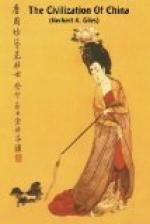Many sports were once common in China which have long since passed out of the national life, and exist only in the record of books. Among these may be mentioned “butting,” a very ancient pastime, mentioned in history two centuries before the Christian era. The sport consisted in putting an ox-skin, horns and all, over the head, and then trying to knock one’s adversary out of time by butting at him after the fashion of bulls, the result being, as the history of a thousand years later tells us, “smashed heads, broken arms, and blood running in the Palace yard.”
The art of boxing, which included wrestling, had been practised by the Chinese several centuries before butting was introduced. Its most accomplished exponents were subsequently found among the priests of a Buddhist monastery, built about A.D. 500; and it was undoubtedly from their successors that the Japanese acquired a knowledge of the modern jiu-jitsu, which is simply the equivalent of the old Chinese term meaning “gentle art.” A few words from a chapter on “boxing” in a military work of the sixteenth century will give some idea of the scope of the Chinese sport.
“The body must be quick to move, the hands quick to take advantage, and the legs lightly planted but firm, so as to advance or retire with effect. In the flying leap of the leg lies the skill of the art; in turning the adversary upside down lies its ferocity; in planting a straight blow with the fist lies its rapidity; and in deftly holding the adversary face upwards lies its gentleness.”
Football was played in China at a very early date; originally, with a ball stuffed full of hair; from the fifth century A.D., with an inflated bladder covered with leather. A picture of the goal, which is something like a triumphal arch, has come down to us, and also the technical names and positions of the players; even more than seventy kinds of kicks are enumerated, but the actual rules of the game are not known. It is recorded by one writer that “the winners were rewarded with flowers, fruit and wine, and even with silver bowls and brocades, while the captain of the losing team was flogged, and suffered other indignities.” The game, which had disappeared for some centuries, is now being revived in Chinese schools and colleges under the control of foreigners, and finds great favour with the rising generation.
Polo is first mentioned in Chinese literature under the year A.D. 710, the reference being to a game played before the Emperor and his court. The game was very much in vogue for a long period, and even women were taught to play—on donkey-back. The Kitan Tartars were the most skilful players; it is doubtful if the game originated with them, or if it was introduced from Persia, with which country China had relations at a very early date. A statesman of the tenth century, disgusted at the way in which the Emperor played polo to excess, presented a long memorial, urging his Majesty to discontinue the practice.




